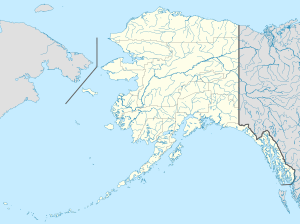Nowitna National Wildlife Refuge facts for kids
Quick facts for kids Nowitna National Wildlife Refuge |
|
|---|---|
|
IUCN Category IV (Habitat/Species Management Area)
|
|
| Location | Alaska, United States |
| Nearest city | Ruby, Alaska |
| Area | 2,100,000 acres (8,500 km2) |
| Established | 1980 |
| Governing body | U.S. Fish and Wildlife Service |
| Website | Nowitna NWR |
The Nowitna National Wildlife Refuge is a huge protected area in Alaska, United States. It's mostly made up of forests and wetlands. These areas are found around the winding Nowitna River.
The weather here includes light rain or snow and mild winds. Winters are long and very cold, while summers are short and fairly warm. Hills around the refuge are topped with alpine tundra, which is a treeless, cold area.
Contents
About the Nowitna Refuge
This amazing wildlife refuge covers about 2,100,000 acres (8,500 km2). That's a really big space for animals to live freely! It would take you a whole week to cross it by canoe. Or, you could fly over it in a small plane for more than an hour.
The Nowitna River is very important to the refuge. About 223 miles (359 km) of its total length flows within the refuge's borders. This river and its connected lakes and streams are home to many types of fish.
Fish Species in the River
You can find several kinds of fish in the Nowitna River. These include sheefish, burbot, and different types of whitefish. There are also sucker fish and two kinds of salmon. These are king salmon and chum salmon. Other fish living here are northern pike and arctic grayling.
Amazing Birdlife
The slow, winding parts of the Nowitna River are like a giant nursery for waterfowl. Many birds come here to raise their young. The grassy edges of the river and nearby lakes are perfect places for them.
Birds That Breed Here
Many migratory birds use this refuge for breeding. These include large trumpeter swans and white-fronted geese. You might also see canvasback ducks and cranes. Over 120 different bird species have been seen here in the summer. Only a few tough species stay through the cold winters.
Mammals of the Refuge
The forests in the lowlands have tall white spruce trees. These trees offer shelter and den sites for animals like martens. Trapping these and other animals for their fur is still important for local people. It helps them earn a living.
Long History of Use
For hundreds of years, the Koyukon Athabascan people have used these lands. They hunt, fish, and trap here. They also do other activities to get food and supplies.
Animals You Might See
You could meet many different mammals anywhere in the refuge. There are two types of foxes. You might also see large moose and wolf packs. Other animals include Canadian lynx, martens, and wolverines. Both black bears and grizzly bears live here too.


